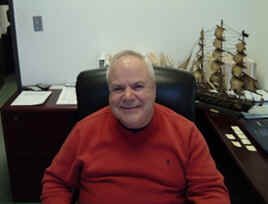|
|
Ruby Mining Company (RUBM.OB) |
|
|
CEOCFO Current
Issue |
This is a printer friendly page! Ruby
Mining’s ATLIS technology is designed to reliably locate and differentiate various
classes of metals through saltwater, sand, rock, coral, mud and wood
Ruby Mining Company (OTCBB: RUBM) is a fifteen
year old technology company located in Atlanta, Georgia that developed a one-of-a-kind,
proprietary, nonferrous metal detection technology to be incorporated into a
remote-sensing device capable of identifying gold and silver bullion, coins and artifacts
located on and beneath the ocean floor. This breakthrough technology will be used in the
world's oceans to search for, locate and recover documented treasure-bearing
shipwrecks. Ruby Mining’s mission is to transform the pursuit of historical marine
treasure into a highly professional, predictable, and profitable business. This will be
accomplished using ecologically and archeologically acceptable methodology. “We had the idea to develop a technology which we are calling ATLIS,
which can distinguish between different metals.” Offers Mr.
Howard Collingwood, president and COO of Ruby Mining Company, “We
have spent much time and money developing this technology over a number of years and have
now developed a technology that can tell the difference between gold, silver, copper,
aluminum, etc. There are a number of technologies generally known as magnetometers that
can tell you whether or not something is a ferrous or non-ferrous metal. There is no other
technology that we know of, and we certainly have looked, that can tell you whether
something is gold or silver.” Asked how they will determine where to search
for treasure Mr. Collingwood tells us, “There
are a great deal of things buried in the ocean; things that you do not want from other
ships that have sunk, anchors, chains, discarded car engines, you name it. Once you locate
a wreck you must determine whether it has any treasure because most wrecks do not have
treasure. You can spend a tremendous amount of money digging up things that are
interesting and a little valuable but not nearly valuable enough to pay for the cost of
the excavation. What we hope to do is to use conventional technologies such as
magnetometers and sonar to locate potential wrecks of interest and then we will use our
technology to see if we can discover gold and silver. If we find the presence of gold or
silver, we will know that this is a very likely treasure ship and would be the ones we
would target first. If we find no indication of gold or silver, we will note the location
of the wreck and we may come back to it at a later date, but that would not be our first
target.” Asked if there was an alternate uses for their technology Mr. Collingwood relates, “The alternate
use for our technology came about unexpectedly. We think that we can find unexploded
ordnance, and the first thing that comes to mind in that area is land mines. I am told
there are two million square acres of unexploded ordnance in the U.S. alone and this would
be bombing ranges and artillery ranges that our military used in the past. Unfortunately,
every bomb that drops does not explode and every artillery shell that is shot does not
explode. Every now and then you will hear about someone finding an unexploded shell or
bomb and disturbing it and it blows up and either kills or hurts them. This has begun to
be recognized by citizens and there is more pressure on the government to clean these
areas up. If you use just a metal detector, there is a lot of metal down there because
they were blowing up bombs and shells routinely for years. It does not do you any good to
just find some metal there; you need to find something that will identify what is there.
Our technology will identify the shape of what is there and will not just give you a
detection of something metallic.” “We are within three or four months of having
our commercial unit in the water operating.” States Mr.
Collingwood addressing investors, “We have a very strong
likelihood within the next four weeks of owning the search vessel New World Legacy, which
was specifically designed to look for shallow water buried treasure. We have a management
team that is more experienced than we ever had, and more money to use than we ever have.
Money is important because it is difficult to do much if you do not have any money. The
fact that we are better funded is enabling us to do things that we wanted to do for a long
time but have not been able to do because we were constrained for cash. If you stand back
and realize this company has been around for a long time and has not done anything and
then look and see what has happened the last few months, you will see a huge difference in
our company. We are on the verge of taking off and that may not be apparent to an investor
that is not closely watching what we are doing.” The Company is also actively exploring
the potential use of its ATLIS technology to assist governmental authorities in locating
unexploded ordnance (bombs, artillery shells, ammunition, weapons, and other potentially
explosive military devices and materials), commonly referred to as ``UXO,'' in both marine
and terrestrial environments. |
|
To view Releases highlight & left click on the company name!
|
|





